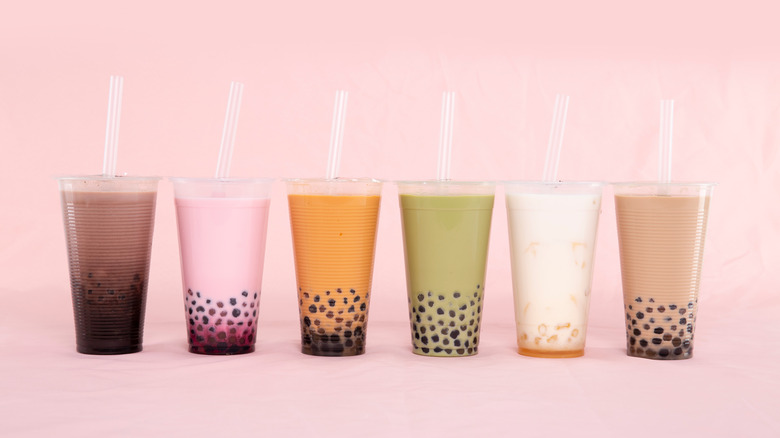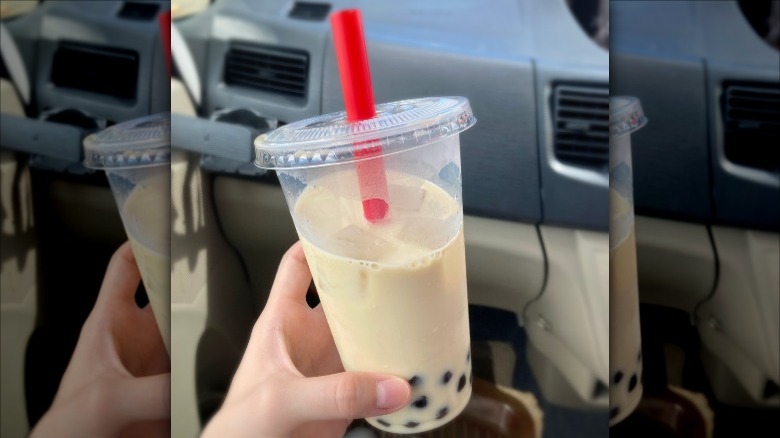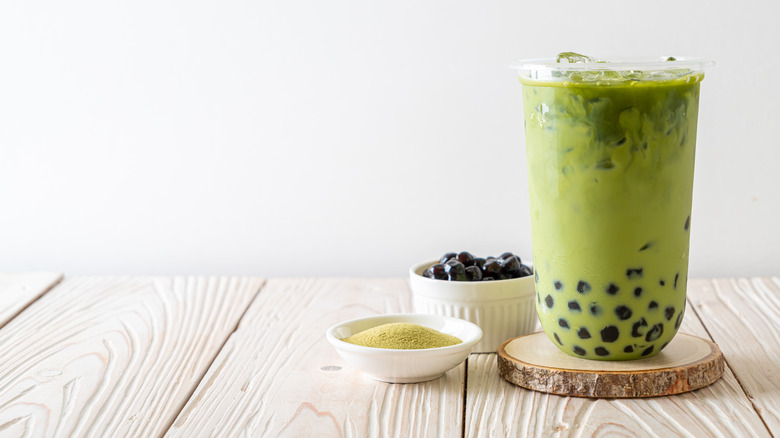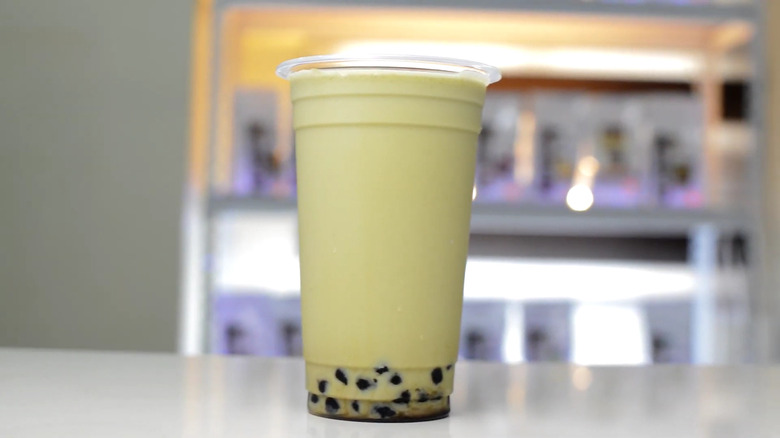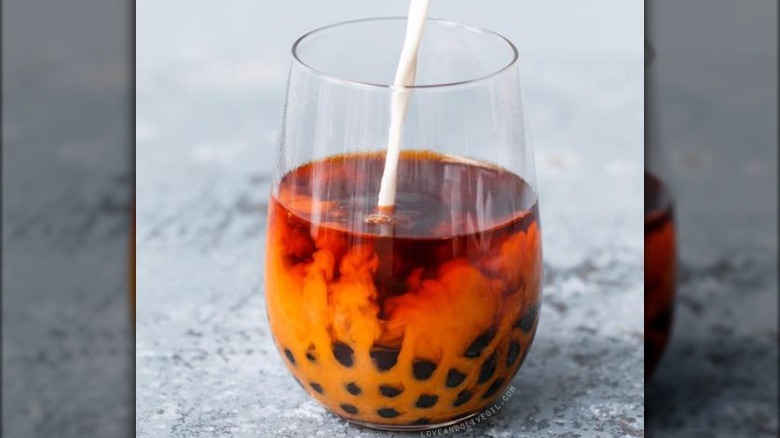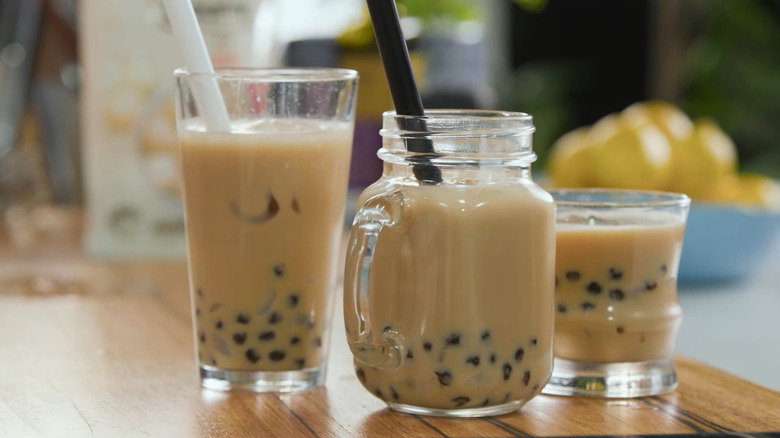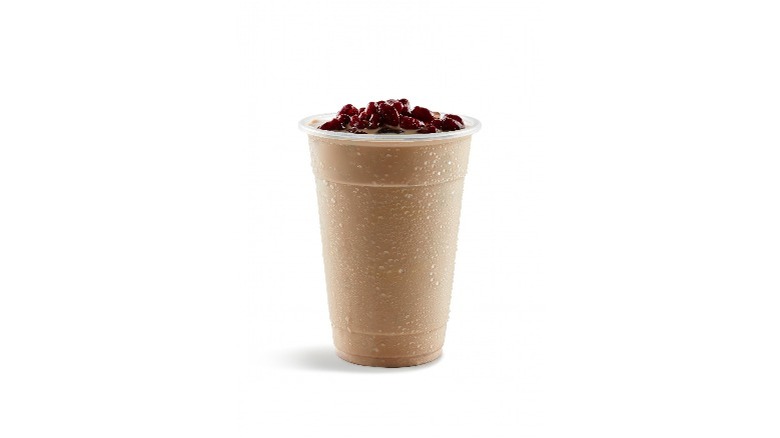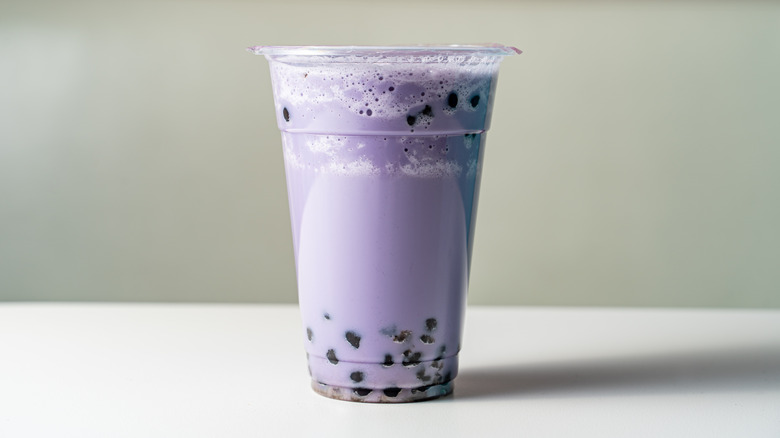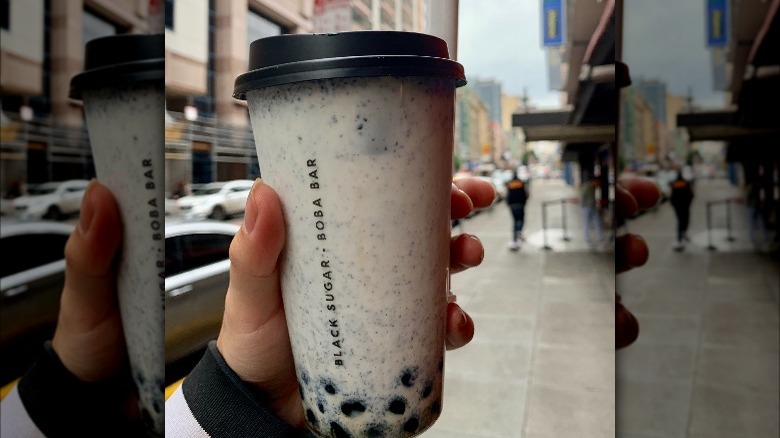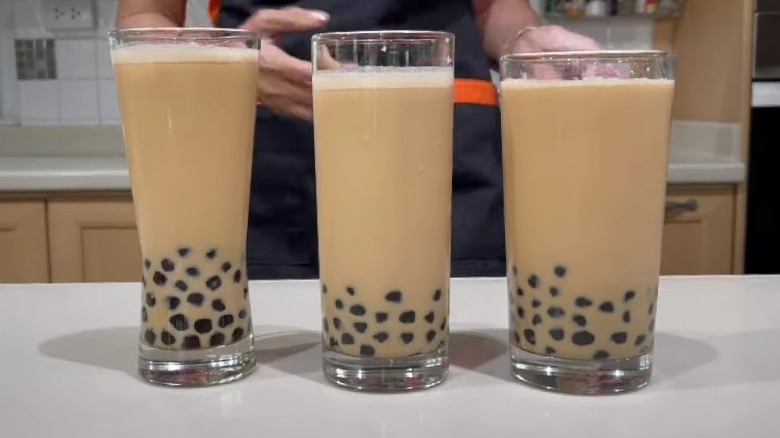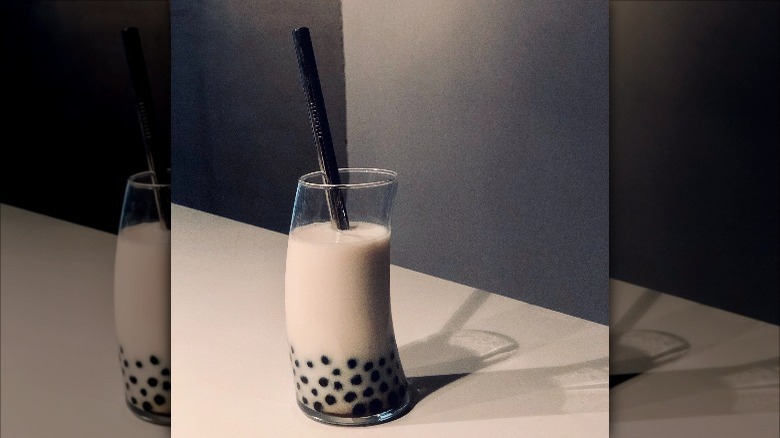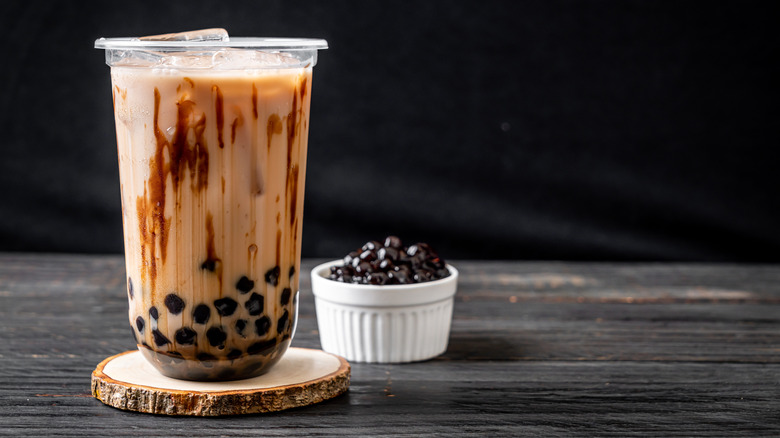The Complete List Of Bubble Tea Flavors, Ranked
Bubble tea, or boba, is a hugely popular drink that Allied Market Research estimates will reach a market value of $4.3 billion by 2027. For those unaware, the drink is made from concentrated tea that is blended with milk. Spheres of tapioca — a starch from the root of the cassava plant — sit at the bottom. These chewy pearls can be flavored, while fruit juices, syrups, and fruit can also be added to the tea itself. In other words, it is a highly customizable drink, per Twinings.
While the exact date and location of bubble tea's invention remain a mystery, most people agree it was created in Taiwan during the latter half of the 20th century. What we do know for sure is that bubble tea was already popular in both Taiwan and Hong Kong during the 1980s and has since gone on to achieve global popularity.
Demand for bubble tea is particularly high in the United States where, as noted food writer Clarissa Wei reports, the drink served as a cultural indicator for young Asian Americans growing up at the turn of the millennium (via LA Weekly). Today, bubble tea's reach is much wider with specialist boba shops offering a huge array of flavors. With this in mind, we have put together a non-exhaustive list of the best bubble tea flavors commonly found across the United States in an effort to help you decide which boba to slurp on next.
12. Jasmine Milk Tea
Many of the most popular bubble tea flavors are ones that have been a part of the regular tea-drinking tradition for centuries. This makes sense, bubble tea is, after all, just another means of enjoying the world's second most popular beverage — tea (via National Geographic). It should come as little surprise then, that jasmine flowers are a popular flavoring for bubble tea, just as it is for regular tea, as noted by Jing Tea.
Jasmine flowers add an unmistakable fragrance to boba. It's one that balances well against the slight bitterness of the base tea, which is most commonly green.
As a delicate flavor and aroma, jasmine bubble teas work best with minimal sweetness and added flavorings. In fact, even the milk itself can mask the gentle hint of jasmine if the tea is not brewed strongly enough.
Aside from flavor and aroma, jasmine also provides a number of health benefits thanks to its high concentration of polyphenols (via Chinese Medicine). This means that jasmine bubble tea is a healthy, delicately flavored choice. However, most boba fans are in it for big, punchy flavors and so jasmine milk tea sits towards the bottom of our list.
11. Matcha Milk Tea
Thanks to a huge amount of publicity concerning its numerous health benefits, matcha — which is made from ground green tea leaves – has become a ubiquitous flavoring across a range of food products. In an interview with The Guardian, Anna Burleigh, a buyer for Selfridges said, "Matcha is used as an ingredient in products across many of our ranges from chocolate, macarons, and biscuits to coffee, nuts, and cold drinks. The unique flavor and reported health benefits have created a loyal customer who seeks out these products."
Time magazine reports that good quality matcha should taste slightly sweet, earthy, and strong. As such, it is not a bubble tea flavor for absolutely everyone. Despite this, matcha is still incredibly popular — so much so that, during the lockdown, Boba Guys' first "make-at-home kit" was matcha flavored, per Time Out. Yet, matcha will always be a slightly divisive taste, and for this reason, it cannot rank higher on our list.
10. Honeydew Milk Tea
In the United States, honeydew has long been an overlooked variety of melon with other popular types, most notably watermelon, dominating public preference (via the United States Department of Agriculture). Yet, when it comes to bubble tea it is honeydew melon that tends to be the most popular of the melon family. As reported by Allied Market Research, the popularity of honeydew is a result of a wider demand for fruit-flavored bubble teas, which is the most popular subgroup of flavoring by a considerable distance.
As NPR notes, the most common base tea for honeydew boba is green tea. When combined with the sweet fruit and blended with ice, the liquid comes to resemble a smoothie. The light texture and refreshing taste make honeydew bubble tea a favorite for hot days in the sun, offering a nice alternative to the dense and often overly sweet boba options.
9. Thai Milk Tea
As reported in the Asian Journal of Food and Agro-Industry, Thai tea is made with a strongly brewed black tea, flavored with spices, such as star anise, before being mixed with evaporated milk. In America, orange food coloring, sugar, and condensed milk are also added. This Americanization is a key facet of Thai tea flavor. In an interview with Food & Wine, Pim Techamuanvivit, a Thai chef and restaurant owner highlights that — despite bearing the country's name — Thai tea is not a national treasure. "It's not this essential element of the culture, it's not something you even necessarily drink every day," he explains. "But somehow it managed to catch the imagination of Americans, so it seems more important to them. It's just not something you would say, proudly, that you love in Thailand."
Nevertheless, the iced beverage has become a popular flavor in and of itself, with Thai tea desserts, and of course bubble teas, springing up in both Thailand and the United States alike. Thai tea-flavored boba is very sweet, thanks to the presence of condensed milk, and even, on occasion, an extra syrup or two. However, the sugar is balanced out by the spiced flavors, making it a favorite of boba drinkers. We're sure the bright orange color doesn't hurt its popularity either.
8. Lychee Milk Tea
Lychees are small fruits native to Southeast Asia that have been an important part of the area's cuisine for millennia (via Britannica). The fruits are most closely associated with China, with the country exporting $53.2 million worth of the fruit in 2020 alone (via Mordor Intelligence). As reported by Macao magazine, thanks to exportation, lychee has spread from China and is now grown in other countries including Vietnam and the United States.
When it comes to bubble tea, lychee is a popular option. Not only is it fruity, but it lacks some of the overpowering sweetness that comes with other popular fruit bobas, like pineapple or mango. Instead, lychee bubble tea is extremely light and refreshing, making it a favorite on sweltering, hot days. Lychee flavor also features heavily in many other bubble teas through the addition of the ever-popular lychee jellies, meaning the flavor has more than earned its place on our list.
7. Chai Milk Tea
Masala chai is one of the most warming, comforting, and enjoyable tea flavors in the world. This has led it to become an integral part of initially Indian, and now global populations (per CNA Lifestyle). Unsurprisingly, masala chai has become a fixture of bubble tea shops around the globe.
While masala chai is the correct term for the spiced tea, in North America the shortened term "chai" is frequently used. Chai bobas, just like traditional masala chai, rely on a heavy blend of spices, including cardamom, cinnamon, and ginger to impart a huge amount of flavor. Of course, these marry perfectly with the taste of strong black tea and the lashings of sugar that bubble teas are often served with.
A fact that many people new to boba might not be aware of is that you can enjoy your boba hot. While not as common as cold bubble tea, hot boba can still be a popular choice, as exemplified by feedback from regular consumers (via Reddit). As a heavily spiced, warming drink, chai milk tea is a wonderful option for those looking to experiment with hot boba, and as such ranks respectively on our list.
6. Red Bean Milk Tea
Red bean paste is a ubiquitous ingredient across East Asian cuisine, being a vital part of Japanese, Chinese, and Korean food cultures (per Breaking Asia). Made from boiled azuki beans, red bean paste is sweet and has been used to add flavor to dishes from as far back as the 7th century, reports Savor Japan. The paste is divided into grades of texture, with each having its own distinct uses. When it comes to boba, koshi-an, the finest paste, is usually preferred because it ensures a uniform texture throughout the drink. This form also negates the risk of whole beans getting sucked up the straw, however, some people like to top the drink with whole red beans.
Red beans have huge cultural significance for countries throughout East Asia, as noted by Breaking Asia, so it is no surprise that their distinct taste has become a feature of bubble tea menus around the world. The taste of red bean bubble tea is delicate, with the beans easily being overpowered by syrups. The quality of the paste is also very important with a well-crafted one resulting in a boba with a mixture of earthy savory-ness and sweet flavor that can't be replicated. And while we understand this flavor is something of an acquired taste (via Reddit), for us, it ranks as one of the best bubble teas available.
5. Taro Milk Tea
As one of the least familiar ingredients on this list, taro may be a bubble tea flavor that is frequently overlooked by many. This is a huge shame, as this particular flavor is stunning to look at and makes a delicious drink. As reported by MasterClass, taro is a root vegetable that is native — as several popular boba ingredients are — to southeast Asia. The taro must be cooked to eliminate toxins and ground before being added to milk tea. It is usually served with a jasmine tea base, the aroma of which combines well with the sweet, nutty flavor of the taro.
As one of the world's oldest food crops, according to the South China Morning Post, taro is a familiar flavor to many in southeast Asia. This, combined with the extremely photogenic, bright purple color it attains when ground, has led to taro milk tea becoming a viral sensation. In boba, the root tastes like a mixture of mild chocolate and vanilla, and as such proves a very popular choice for many boba aficionados.
4. Black Sesame Milk Tea
Black sesame has a long history when it comes to Asian cuisines. In China, the seeds are transformed into a pitch-black dessert soup, while in Japan they are often used as yakumi, condiments that amplify the overall taste of a dish. According to Taiwan Panorama, black sesame oil is frequently used in cooking in Taiwan.
The popularity of back sesame in the East has slowly bled into the West. Since the early 2000s, black sesame has become a fixture of sweet dishes across Europe and the United States, per the Los Angeles Times. Since then, the global popularity of black sesame has only grown. This fact was attested to by Starbucks' release of a black sesame tea latte — proof, if ever there was, of a previously niche ingredient making it into the mainstream (via Forbes).
When used in bubble tea, black sesame offers a much-needed respite from the overly sweet options that usually fill menus. It is nutty and slightly savory, a taste that some find highly addictive. This, combined with its appetizing, cookies and cream-style appearance, has led us to rank it as one of the best bubble tea flavors available.
3. Black Milk Tea
No list of bubble tea flavors would be complete without the original flavor — black milk tea. However, black milk tea doesn't just feature on this list because of nostalgia alone. In fact, black tea is the most popular base ingredient of bubble tea by far and is expected to remain so up to — and most likely beyond — 2027, as reported by Allied Market Research. Because of the tea's huge global popularity, many are familiar with the taste. As such, black tea is a low-risk, unintimidating option for those ordering bubble tea for the first time.
Black milk tea is usually served with equally understated black tapioca balls. This gives an opportunity for the tea itself to shine, something which is not all that common when it comes to boba. The type of black tea used, such as black assam, darjeeling, or English breakfast, affects the end result, marking this boba a classic drink that will appeal to regular tea-drinking enthusiasts. In short, black tea boba is simple but highly effective.
2. Horchata Milk Tea
Horchata is a drink that is made from milk, water, rice, and cinnamon along with other flavorings like vanilla. However, there are many different types of horchata, depending on which part of the world you are in. Spain, Puerto Rico, and Nigeria all have their own versions of the beverage, thanks to the drink being exported from North Africa where it was invented over 4,000 years ago (via Loyal Nana). For the purposes of this article, we will be referring to the Mexican version as this is the dominant type found in the United States.
Perhaps the most famous horchata milk tea comes from Boba Guys, a bubble tea company founded in 2011 by friends Bin Chen and Andrew Chau. Speaking to Giant Robot Media, Chen said, "We kind of had a science motif because we weren't experts in the beginning. We only had three drinks that we could make reliably. They were the classic, the jasmine, and the soy milk tea. Those were the three drinks we always had on hand. But every week we would always have an idea for a new drink. Horchata Boba was one of them."
Since then, horchata milk tea has become one of the brand's most iconic flavors, even though it doesn't include tea at all. Despite not being traditional, horchata boba is so delicious it simply had to rank high on our list.
1. Brown Sugar Milk Tea
As reported by the Michelin Guide, brown sugar boba was invented by the bubble tea brand Tiger Sugar, which opened in Taiwan in 2017. The flagship product — made with brown sugar caramel — was an instant hit thanks to its incredible flavor and beautiful striped appearance. CNN Travel reports that the drink was so popular that it wasn't uncommon to queue for hours to get this iconic boba from Tiger Sugar.
However, brown sugar milk tea does come with a caveat and quite a large one at that. It is perhaps the unhealthiest bubble tea you can order. As highlighted by Next Shark, Mount Alvernia Hospital, a medical institution in Singapore found that a serving of brown sugar bubble tea contains 18.5 teaspoons of sugar. To put that into perspective, the daily recommended allowance is 6 to 9 teaspoons (via Harvard T.H. Chan School of Public Health).
What's even more astounding is that while it's one of the most sought-after bubble teas on the market, it does not usually contain any tea at all. Rather it is simply a blend of brown sugar caramel, milk, and tapioca pearls. However, this fact doesn't seem to have dented demand with the beverage being sold in one version or another by nearly all bubble tea shops and stalls.
